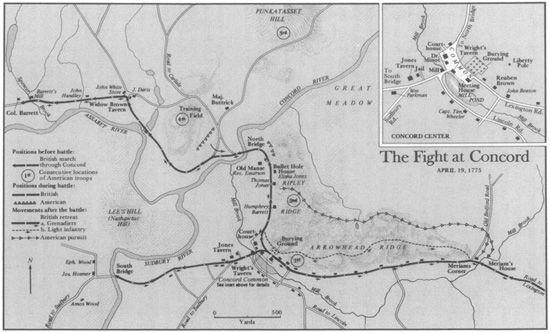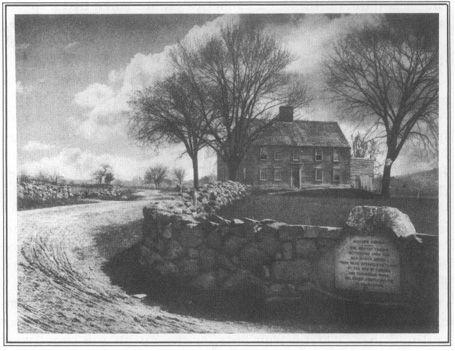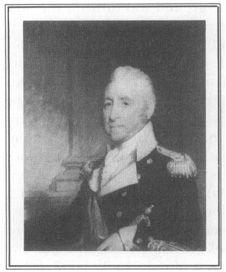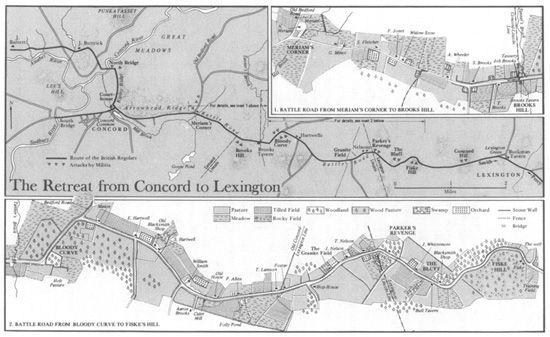Paul Revere's Ride (38 page)
Read Paul Revere's Ride Online
Authors: David Hackett Fischer
Tags: #General, #Biography & Autobiography, #History, #United States, #Historical, #Revolutionary Period (1775-1800), #Art, #Painting, #Techniques


That report was false, but what had actually happened was bad enough. A wanton atrocity had been committed by a young Concord man, and witnessed by four companies of British troops. It instantly changed the tone of the engagement. Many British Regulars had long felt contempt for New England Yankees; now a spirit of hatred began to grow. The thin veneer of 18th-century civility was shattered by this one atrocity at the North Bridge. It would lead to many others by both sides before the day was out.
The morning hours were rapidly consumed by these events. It was half past eleven before all of the Regulars were back in Concord center. Still, for some unknown reason, Colonel Smith held his men in the town for another thirty minutes. Why he did so is unclear. The Americans, watching from the hills north of the town, observed what they took to be signs of fatal indecision. “For half an hour,” Emerson wrote contemptuously, “the Enemy by their marches and countermarches discovered great fickleness and inconstancy of mind, sometimes advancing, sometimes returning to their former posts.”
55
North of the village, the Americans began to move east across the hills, threatening to cut off the road from Concord to Boston. Smith sent three companies to the high ground north of the highway, with orders to hold open his line of retreat. At the same time he reorganized his command, and formed it into a marching column. Men from broken units were seconded to other formations. The light infantry of the King’s Own was so shattered by its losses at the North Bridge that it was attached to other companies. Horse-drawn chaises were taken from Concord stables to serve as ambulances. Wounded officers were tucked into the small vehicles, and were made as comfortable as possible on pillows and mattresses that had been stripped from Concord beds. Wounded soldiers of “other ranks” were left to shift for themselves. The walking wounded joined the column with bloody bandages around arms and heads, trying desperately to keep up in fear of American hatchets and scalping knives. Severely wounded private soldiers were left behind.
56
At high noon the British column was at last ready to march. Colonel Smith lifted his heavy body into the saddle, and gave the order to move out. His command set off in a long column on the road to Boston, nearly twenty miles away. As he rode out, Smith studied the hills surrounding the town, and saw “vast numbers assembling in many parts.” He noticed a high ridge that rose abruptly on the north side of the Boston road and ran alongside the highway from Concord center for nearly a mile. A large party was ordered to secure the ridge, and protect the flank of the column. Other flankers were sent into low open meadows south of the road. This tactic was successful. No fighting occurred as the Regulars marched the first mile from Concord.

Meriam’s Corner and the Meriam farmhouse, in a 19th-century photograph. The season appears to be early Spring. The trees are still bare, as they were on April 19, 1775. The countryside was more open than today, when the forest has reclaimed the fields and rocky pastures. The ruts of light chaises are visible in the unpaved road. The ash in front of the house is still standing today. (Concord Free Public Library
Farther on, the long ridge ended at a place called Meriam’s Corner, an important road junction where several country lanes came together and the highway crossed a small bridge over a stream.
57
Many militia and minutemen were arriving on those roads—parts of two regiments from Chelmsford, Reading, and
Billerica to the north. One of Billerica’s minutemen had a special reason for being there. He was Private Thomas Ditson, the Yankee pedlar who had been tarred and feathered in Boston by the soldiers of the 47th Foot.
58
The men from Tewksbury also reached Meriam’s Corner about noon, having mustered and marched twenty miles since 2 o’clock that morning. Other companies were coming up from Sudbury and Framingham, as far as fifteen miles to the south, and joined forces with the companies that had fought at Concord Bridge. The American strength was now more than 1000, larger than Smith’s force for the first time that day.
59
At least six colonels of Massachusetts militia were in the field, and took a leading part at Meriam’s Corner. Lieutenant-Colonel William Thompson, a veteran of two colonial wars, formed three companies from his hometown of Billerica into a line running east from the Meriam farmhouse. Colonel David Green brought five companies alongside Thompson. Tewksbury’s Captain John Trull also led his company to the line, formed them up in close order and told them, “Stand trim boys, or the rascals will shoot your elbows off!”
60
Other men took positions as skirmishers in the fields, or found cover in the farm buildings. Major John Brooks led his Reading minutemen into a strong position “covered by a barn and walls around it,” about 100 yards from the bridge.
61
As the Regulars approached Meriam’s Corner, the British flank guard came down off the hill to cross the bridge. This time there were no fifes and drums, no “grand musick,” and none of the pageantry of 18th-century war. Nothing was heard but the tramp of the weary infantry, and the mournful creak of the ambulance carriages. A Reading man, Edmund Foster, remembered that “silence reigned on both sides.”
Suddenly the silence was broken by a musket shot. Probably an American militiaman fired first, and missed at extreme range. The Regulars turned, presented muskets, and discharged a volley. The balls buzzed above the heads of the militia. Once again, by accident or design, the British troops had fired high. No New England men were hit.
62
The Americans returned fire with greater accuracy. At least two Regulars fell dead, and another officer was wounded, Lieutenant Lister of the 10th Foot. As many as half a dozen British soldiers may have been hit in rapid succession before the column moved out of range. Amos Barrett followed the retreating Regulars into the road. He remembered, “When I got there, a great many lay dead and the road was bloody.”
63

Major John Brooks was a country doctor who showed a high talent for command on April 19. On the road to Concord, he collected three or four militia companies and led them into action at Meriam’s Corner, Lincoln Woods, Lincoln Plain, and Fiske Hill. Later he rose to the rank of brigadier general. This painting by Gilbert Stuart is in the Honolulu Academy of Art.
The British column hurried on past Meriam’s Corner, into a cultivated countryside of fields, orchards, meadows and pastures. The road and landscape were very different from their appearance today. Historian Allen French observes that “the present broad highway, with its few curves and easy grades, gives little idea of the one of 1775. The narrow road dropped at times into small ravines which were commanded by hillsides above. At least two large sections of the road bent to the northward, rejoining the modern road after a detour.” Many of these ravines and hillocks were leveled in the 19th century, and sharp bends were taken out.
64
The terrain was not as densely wooded as today, but more open along the road. Fields were lined with stone “fences,” not the neat masonry walls of myth, but straggling piles of rough granite rocks, topped with heavy logs and split rails to a considerable height, and not easy for a man to cross. Much of the land by the side of the highway consisted of rock-studded pastures, open meadows, and arable fields, subdivided by complex systems of drainage ditches, and joined by nearly invisible lanes that threaded their way through swamps and soft ground from one holding to the next. The people who lived in the countryside could move
easily through this terrain, but the ground was difficult for men unfamiliar with it.
The open land along the road was broken by patches of orchard and woodlots on rising and rocky ground. Well back from the road were large tracts of woodland, of such a size that the area was called “Lincoln Woods.” Even the forested tracts tended to be comparatively open, with long views through the trees. The hardwoods were still leafless on April 19. Ensign De Berniere remembered seeing that “all the hills on each side of us were covered with rebels.” Colonel Smith sent out his flanking parties again. A few militiamen fired at long range, but the flankers kept them at a distance from the fast moving column.
65
A mile beyond Meriam’s Corner the road entered a stretch of rising ground that was called Brooks Hill, after a tavern and several farms owned by several members of the Brooks family.
66
As the British column reached the hill, they observed a large force of American militia gathering in close formation on the high ground ahead. Sutherland remembered, “Here I saw upon a height to my right hand a vast number of armed men drawn out in Battalia order, I dare say near 1000 who on our coming nearer dispersed into the woods.” By “battalia,” he meant “line of battle.”
67
The American militia officers saw an opportunity here. As many as nine companies from Framingham and Sudbury, nearly 500 men, reached this part of the road before the Regulars. They were led by able and experienced officers—Lieutenant-Colonel Thomas Nixon, his older brother Captain John Nixon, and Captains Nathaniel Cudworth, Simon Edgell, Micajeh Gleason and Jesse Eames. Five of these six men were combat veterans who had served together in the French and Indian War. They were accustomed to working as a team, and used their experience to prepare an ambush in the woods south of the road.
68
The trap was sprung too soon. The Americans were visible in the woods, still bare of foliage, and some militiamen may have fired prematurely. Smith’s vanguard charged straight up the hill toward the Americans, with the gallantry for which British infantry were renowned. The Americans stood their ground, and the British force was hit by heavy volleys of plunging fire from the Framingham and Sudbury men on the slope above them.
69
In Nixon’s company of Sudbury minutemen, two men fought side by side at Brooks Hill. One was a tense and nervous youngster who had never been in action before. The other was a tough old soldier, a Scottish immigrant named John Weighton who had survived Braddock’s defeat, and said that he “had been in seven battles, and this eight.” The green young minuteman recalled that “after we had discharged our guns I observed to the Scot, who appeared very composed, I wished I felt as calm as he appeared to be.” The old soldier answered, “It’s a trade to be larnt.” His young friend wrote later, “Before I served through one campaign, I found the Scot’s remark a just one.”
70

